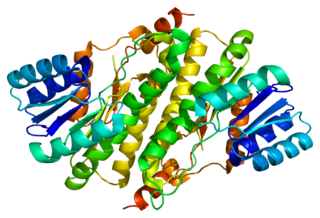
11β-Hydroxysteroid dehydrogenase type 1, also known as cortisone reductase, is an NADPH-dependent enzyme highly expressed in key metabolic tissues including liver, adipose tissue, and the central nervous system. In these tissues, HSD11B1 reduces cortisone to the active hormone cortisol that activates glucocorticoid receptors. It belongs to the family of short-chain dehydrogenases. It is encoded by the HSD11B1 gene.
17β-Hydroxysteroid dehydrogenases, also 17-ketosteroid reductases (17-KSR), are a group of alcohol oxidoreductases which catalyze the reduction of 17-ketosteroids and the dehydrogenation of 17β-hydroxysteroids in steroidogenesis and steroid metabolism. This includes interconversion of DHEA and androstenediol, androstenedione and testosterone, and estrone and estradiol.

17β-Hydroxysteroid dehydrogenase 1 (17β-HSD1) is an enzyme that in humans is encoded by the HSD17B1 gene. This enzyme oxidizes or reduces the C17 hydroxy/keto group of androgens and estrogens and hence is able to regulate the potency of these sex steroids

Aldo-keto reductase family 1 member C3 (AKR1C3), also known as 17β-hydroxysteroid dehydrogenase type 5 or 3α-hydroxysteroid dehydrogenase type 2 (3α-HSD2) is a steroidogenic enzyme that in humans is encoded by the AKR1C3 gene.

17-β-Hydroxysteroid dehydrogenase X (HSD10) also known as 3-hydroxyacyl-CoA dehydrogenase type-2 is a mitochondrial enzyme that in humans is encoded by the HSD17B10 gene. Several alternatively spliced transcript variants have been identified, but the full-length nature of only two transcript variants has been determined. Human HSD10 cDNA was cloned from the brain (NM_004493), and the resulting protein, a homotetramer, was first characterized as a short chain 3-hydroxyacyl-CoA dehydrogenase (SCHAD). Active sites of this enzyme can accommodate different substrates; 17β-HSD10 is involved in the oxidation of isoleucine, branched-chain fatty acids, and xenobiotics as well as the metabolism of sex hormones and neuroactive steroids.

Aldo-keto reductase family 1 member C1 also known as 20α-hydroxysteroid dehydrogenase, 3α-hydroxysteroid dehydrogenase, and dihydrodiol dehydrogenase 1/2 is an enzyme that in humans is encoded by the AKR1C1 gene.

17β-Hydroxysteroid dehydrogenase 2 (17β-HSD2) is an enzyme of the 17β-hydroxysteroid dehydrogenase (17β-HSD) family that in humans is encoded by the HSD17B2 gene.

Sterol-4-alpha-carboxylate 3-dehydrogenase, decarboxylating is an enzyme that in humans is encoded by the NSDHL gene. This enzyme is localized in the endoplasmic reticulum and is involved in cholesterol biosynthesis.

Aldo-keto reductase family 1 member C4, also known as 3α-Hydroxysteroid dehydrogenase type 1 (3α-HSD1), is an enzyme that in humans is encoded by the AKR1C4 gene. It is known to be necessary for the synthesis of the endogenous neurosteroids allopregnanolone, tetrahydrodeoxycorticosterone, and 3α-androstanediol. It is also known to catalyze the reversible conversion of 3α-androstanediol (5α-androstane-3α,17β-diol) to dihydrotestosterone and vice versa.

3-keto-steroid reductase is an enzyme that in humans is encoded by the HSD17B7 gene.

Estradiol 17 beta-dehydrogenase 8 is an enzyme that in humans is encoded by the HSD17B8 gene.

Retinol dehydrogenase 12 is an enzyme that in humans is encoded by the RDH12 gene.

Estradiol 17-beta-dehydrogenase 12 is an enzyme that in humans is encoded by the HSD17B12 gene.

Estradiol 17-beta-dehydrogenase 11 is an enzyme that in humans is encoded by the HSD17B11 gene.

Short-chain dehydrogenase/reductase 3 is an enzyme that in humans is encoded by the DHRS3 gene.

Dehydrogenase/reductase SDR family member 9 is an enzyme that in humans is encoded by the DHRS9 gene.

Hydroxysteroid 17-beta dehydrogenase 6 is an enzyme that in humans is encoded by the HSD17B6 gene.

Dehydrogenase/reductase X-linked also known as DHRSX is an enzyme which in humans is encoded by the pseudoautosomal DHRSX gene. DHRSX is a member of the short-chain dehydrogenase family of oxidoreductase enzymes.

Retinol dehydrogenase 13 (all-trans/9-cis) is a protein that in humans is encoded by the RDH13 gene. This gene encodes a mitochondrial short-chain dehydrogenase/reductase, which catalyzes the reduction and oxidation of retinoids. The encoded enzyme may function in retinoic acid production and may also protect the mitochondria against oxidative stress. Alternatively spliced transcript variants have been described.

Aldo-keto reductase family 1 member C2, also known as bile acid binding protein, 3α-hydroxysteroid dehydrogenase type 3 (3α-HSD3), and dihydrodiol dehydrogenase type 2, is an enzyme that in humans is encoded by the AKR1C2 gene.




















